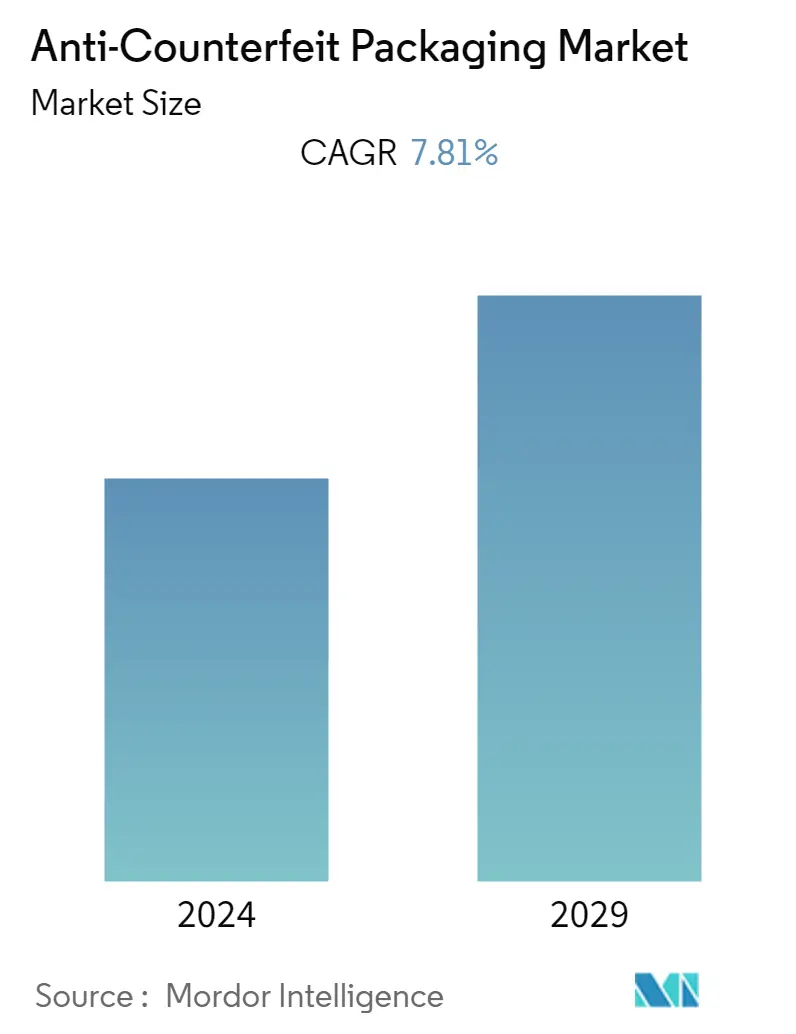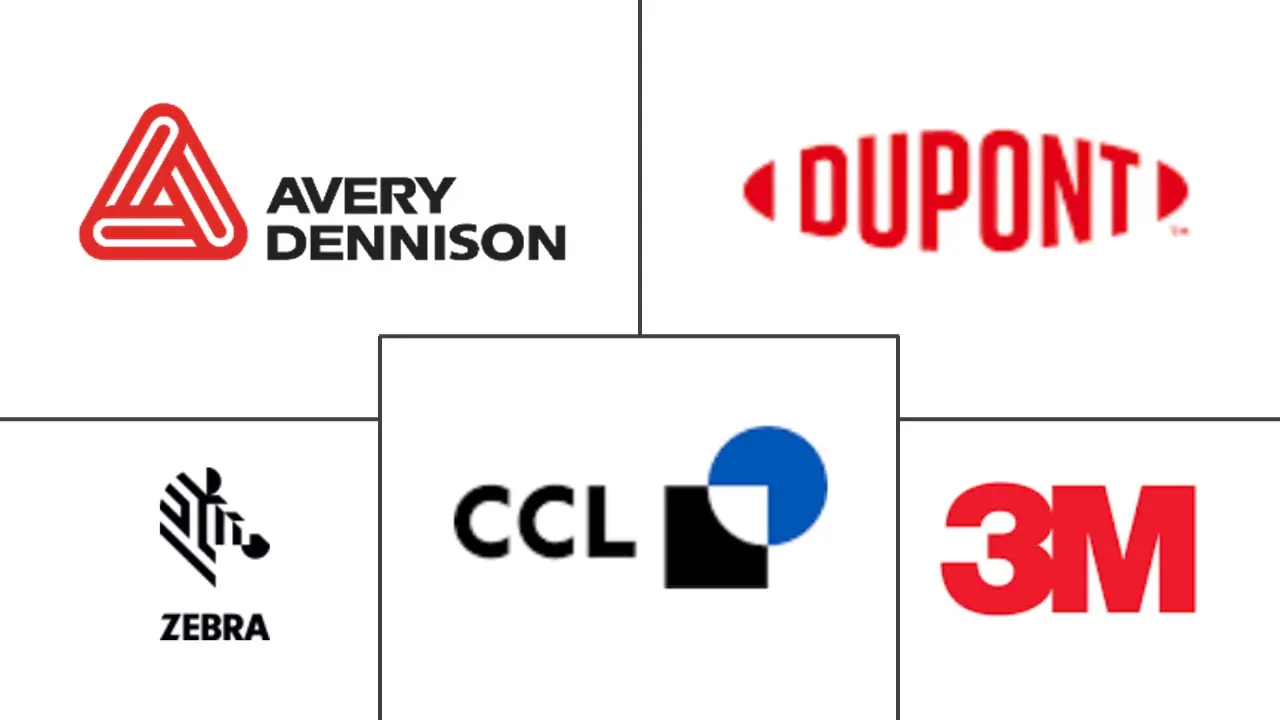
| Study Period | 2019 - 2029 |
| Base Year For Estimation | 2023 |
| Forecast Data Period | 2024 - 2029 |
| CAGR | 7.81 % |
| Fastest Growing Market | Asia Pacific |
| Largest Market | North America |
| Market Concentration | Medium |
Major Players
*Disclaimer: Major Players sorted in no particular order |
Anti-Counterfeit Packaging Market Analysis
The anti-counterfeit packaging market is projected to register a CAGR of 7.81% during the forecast period (2022-2027). The evolving regulatory landscape for the protection of authenticity of life-critical products, technological advancements in improving anti-theft measures, increasing diversity in the ongoing threats, and the need for brand protection have been instrumental in fueling the growth of the anti-counterfeit packaging market.
- The introduction of regulations, such as the Anti-counterfeiting Trade Agreement by the United States and the labeling and serialization measures by the EU Commission, is expected to positively impact the market in the developed economies over the forecast period.
- In May 2022, according to the Hindu, HP India seized INR 40 crore worth 4,98,000 counterfeit products between July 2020 and September 2021 under its Anti-Counterfeiting and Fraud (ACF) Programme in the country, which is an indicator of a severe threat to the consumer's health in India and worldwide. The developing economies, also known to be the major importers of drugs, are the most affected regions due to this trade.
- Countries such as China, India, South Korea, Brazil, and Turkey, have introduced procedures designed to tighten the pharmaceutical industry's supply chain security. Silicon dioxide-based tags are being used as it is affirmed by the US Food and Drug Administration as generally recognized as safe (GRAS) and considered fit for human consumption.
- However, High setup and innovation costs are required to manufacture anti-counterfeit packaging, discouraging new entrants and potential clients from accepting anti-counterfeit solutions and slowing market growth. Furthermore, some existing technologies, such as barcodes and QR codes, are easy to replicate without proper customer awareness, limiting market growth.
- The coronavirus pandemic spread significantly impacted the supply chain of packaging companies, resulting in a shortage of raw materials such as plastics and labeling papers. In addition, a slight decrease in demand for FMCG products was observed in the first quarter of 2020 as people feared Covid contraction by touching the packaging products. However, packaging companies and authentication technology providers concentrated on developing solutions to effectively communicate the benefits of anti-counterfeit packaging in addressing the impact of Covid-19 and ensuring the safety and quality of their packaging materials while keeping an eye on employee health and well-being.
Anti-Counterfeit Packaging Industry Segmentation
Anti-counterfeiting packaging is incorporated to prevent imitation and it confirms the safety of the goods. These measurements are taken by companies to help them minimize losses due to counterfeiting, in-terms of revenue and loyalty. The counterfeiting industry is flourishing, and it is not only the consumer goods market that is affected. There has been an increase in the counterfeit prescription drugs, car parts, and technologies (such as cell phone batteries) which is flooding the market in future.
The Anti-counterfeit Packaging Market is segmented by Technology (Trace and Track, Tamper-evident, Covert, Overt, and Forensic Markers), End User (Food and Beverages, Healthcare and Pharmaceuticals, Industrial and Automotive, Consumer Electronics, and Other End Users), and Geography.
| Trace and Track |
| Tamper-evident |
| Covert |
| Overt |
| Forensic Markers |
| Food and Beverage |
| Healthcare and Pharmaceuticals |
| Industrial and Automotive |
| Consumer Electronics |
| Other End Users |
| North America | United States |
| Canada | |
| Europe | United Kingdom |
| Germany | |
| France | |
| Italy | |
| Spain | |
| Rest of Europe | |
| Asia-Pacific | China |
| India | |
| Japan | |
| Australia | |
| Rest of Asia-Pacific | |
| Latin America | Brazil |
| Argentina | |
| Rest of Latin America | |
| Middle-East & Africa | South Africa |
| United Arab Emirates | |
| Rest of Middle-East & Africa |
Anti-Counterfeit Packaging Market Size Summary
The anti-counterfeit packaging market is experiencing significant growth, driven by the need for brand protection and the evolving regulatory landscape aimed at safeguarding the authenticity of life-critical products. Technological advancements in anti-theft measures and the increasing diversity of threats have further fueled this market's expansion. Regulatory measures such as the Anti-counterfeiting Trade Agreement in the United States and labeling and serialization initiatives by the EU Commission are expected to positively impact developed economies. However, the market faces challenges, including high setup and innovation costs, which deter new entrants and slow growth. Existing technologies like barcodes and QR codes are also easily replicable, limiting their effectiveness. The COVID-19 pandemic disrupted supply chains, causing raw material shortages and a temporary decline in demand for FMCG products, but companies have since focused on communicating the benefits of anti-counterfeit packaging.
North America stands out as a significant market for anti-counterfeit packaging, driven by increasing consumer demand for various products and a strong emphasis on brand protection. The region's mature market and refined regulations have bolstered its market share, despite challenges like high setup costs and less investment in R&D. The market is moderately competitive, with a few major players dominating, but many companies are expanding their presence through innovative and sustainable packaging solutions. Recent acquisitions and product introductions, such as Authentix's acquisition of Strategic IP Information and OPTEL's IdentifAI, highlight the industry's focus on enhancing digital security and product authentication. These developments underscore the market's commitment to addressing counterfeit threats and meeting growing consumer demands for transparency and traceability.
Anti-Counterfeit Packaging Market Size - Table of Contents
1. MARKET DYNAMICS
- 1.1 Market Overview
-
1.2 Market Drivers
- 1.2.1 Booming E-commerce Industry
- 1.2.2 Increasing Focus of Manufacturers on Brand Protection
-
1.3 Market Restraints
- 1.3.1 High-initial Costs
-
1.4 Industry Attractiveness - Porter's Five Forces Analysis
- 1.4.1 Threat of New Entrants
- 1.4.2 Bargaining Power of Buyers/Consumers
- 1.4.3 Bargaining Power of Suppliers
- 1.4.4 Threat of Substitute Products
- 1.4.5 Intensity of Competitive Rivalry
- 1.5 Technology Snapshot
2. MARKET SEGMENTATION
-
2.1 By Technology
- 2.1.1 Trace and Track
- 2.1.2 Tamper-evident
- 2.1.3 Covert
- 2.1.4 Overt
- 2.1.5 Forensic Markers
-
2.2 By End User
- 2.2.1 Food and Beverage
- 2.2.2 Healthcare and Pharmaceuticals
- 2.2.3 Industrial and Automotive
- 2.2.4 Consumer Electronics
- 2.2.5 Other End Users
-
2.3 By Geography
- 2.3.1 North America
- 2.3.1.1 United States
- 2.3.1.2 Canada
- 2.3.2 Europe
- 2.3.2.1 United Kingdom
- 2.3.2.2 Germany
- 2.3.2.3 France
- 2.3.2.4 Italy
- 2.3.2.5 Spain
- 2.3.2.6 Rest of Europe
- 2.3.3 Asia-Pacific
- 2.3.3.1 China
- 2.3.3.2 India
- 2.3.3.3 Japan
- 2.3.3.4 Australia
- 2.3.3.5 Rest of Asia-Pacific
- 2.3.4 Latin America
- 2.3.4.1 Brazil
- 2.3.4.2 Argentina
- 2.3.4.3 Rest of Latin America
- 2.3.5 Middle-East & Africa
- 2.3.5.1 South Africa
- 2.3.5.2 United Arab Emirates
- 2.3.5.3 Rest of Middle-East & Africa
Anti-Counterfeit Packaging Market Research FAQs
What is the current Anti-Counterfeit Packaging Market size?
The Anti-Counterfeit Packaging Market is projected to register a CAGR of 7.81% during the forecast period (2024-2029)
Who are the key players in Anti-Counterfeit Packaging Market?
Avery Dennison Corporation, CCL Industries Inc., 3M Company, Zebra Technologies Corporation and E.I. Du Pont De Nemours and Company are the major companies operating in the Anti-Counterfeit Packaging Market.


